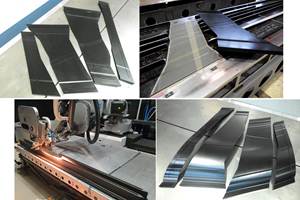Speaking Out: Composite Structural Design and Manufacturing ... the Times are A-Changin&'
In the early 1990s, I had the pleasure of working on one of the largest aerospace composites research and development (R&D) projects that has ever been conducted. The program focused on composite fuselage and wing structure for large aircraft. Designs were developed and manufacturing processes were demonstrated at
Share
In the early 1990s, I had the pleasure of working on one of the largest aerospace composites research and development (R&D) projects that has ever been conducted. The program focused on composite fuselage and wing structure for large aircraft. Designs were developed and manufacturing processes were demonstrated at the subscale level for composite primary structures on a large transport aircraft.
The aircraft company that led this program based its design concept on several considerations: structural efficiency, manufacturing cost, repair feasibility and manufacturing risk. The design was similar to current aluminum designs, however, by using stronger, lighter-weight materials (e.g., carbon composites), a much better aircraft could be built. The fuselage design developed and demonstrated on this R&D program was an assembly of stringer-stiffened panels. However, with composites, much larger panels were possible than with conventional aluminum designs.
The fuselage manufacturing process was based on fiber placement of large panels and the use of “batch” processing (multiple parts on one tool) to help achieve desired cost goals. Cocuring the skins and stringers also helped reduce assembly cost. During the design studies on this project, a one-piece, closed 360° barrel section design was evaluated, but ultimately rejected in the final design downselect.
According to the design engineers, there were several compelling reasons to not use the one-piece, barrel section design, which primarily revolved around tooling issues, repair concerns and process risk issues. In addition, fiber placement machines that could build a full-scale, large-diameter fuselage barrel section were not available at the time. The program’s engineers concluded that the most attractive advantage of the one-piece barrel section design was “speed of manufacture.” If it were possible to produce the one-piece fuselage barrel section, much assembly effort and cost could be eliminated and the production rate could be increased.
A few years later, I was in a meeting for another composites R&D program where several airline maintenance representatives were critical of the composites industry’s desire to build large, one-piece structures. The airline reps said they liked parts that can be “removed and replaced” when damaged. As I listened to their comments, they seemed to validate the panel assembly design that was ultimately selected in the R&D program in which I had participated.
Now, fast-forward about 15 years. We find that the new fuselage design for The Boeing Co.’s 787 Dreamliner is exactly what the engineers on that big R&D program had rejected. What happened? How did this once-rejected design concept come to be today’s preferred design?
Manufacturing technology advancements have enabled engineers to design composite structures today that were just not feasible to build 15 years ago. Fiber placement machines now are available in much larger sizes, and new delivery heads can run wider materials to achieve better layup rates. Raytheon Aircraft’s success with business jet fuselage structures consisting of closed, 360° barrel sections validated this design — and confirmed fiber placement’s suitability for its manufacture. In addition, more machine tool companies are getting involved with fiber placement and bringing new innovations to this process. Fiber placement machines soon will be available that can cut and lay down material as fast as 2,400 inches per minute (61m per minute).
Automated tape laying (ATL) technology also has advanced. The latest ATL machines are faster, more capable of laying complex laminates, and they are available in a wide range of sizes and capabilities. The big ATL systems that are being used to build the 787 wing skins are the largest composites machine tools ever built for aerospace applications.
I suspect the “speed of manufacture” advantage was one of the major considerations when this design was selected for the 787 fuselage sections. Assuming the 787 fuselage manufacturing process works as well as expected, Boeing will have hit a home run. Transport aircraft will be changed forever.
The 787 is a bold statement that composites have arrived. I am one of many people in the composites industry who look forward to the day we can ride on commercial aircraft that are made mostly with composite materials, and that day will be here very soon.
Related Content
Plant tour: Spirit AeroSystems, Belfast, Northern Ireland, U.K.
Purpose-built facility employs resin transfer infusion (RTI) and assembly technology to manufacture today’s composite A220 wings, and prepares for future new programs and production ramp-ups.
Read MorePlant tour: Joby Aviation, Marina, Calif., U.S.
As the advanced air mobility market begins to take shape, market leader Joby Aviation works to industrialize composites manufacturing for its first-generation, composites-intensive, all-electric air taxi.
Read More3D-printed CFRP tools for serial production of composite landing flaps
GKN Aerospace Munich and CEAD develop printed tooling with short and continuous fiber that reduces cost and increases sustainability for composites production.
Read MoreJeep all-composite roof receivers achieve steel performance at low mass
Ultrashort carbon fiber/PPA replaces steel on rooftop brackets to hold Jeep soft tops, hardtops.
Read MoreRead Next
Plant tour: Daher Shap’in TechCenter and composites production plant, Saint-Aignan-de-Grandlieu, France
Co-located R&D and production advance OOA thermosets, thermoplastics, welding, recycling and digital technologies for faster processing and certification of lighter, more sustainable composites.
Read MoreAll-recycled, needle-punched nonwoven CFRP slashes carbon footprint of Formula 2 seat
Dallara and Tenowo collaborate to produce a race-ready Formula 2 seat using recycled carbon fiber, reducing CO2 emissions by 97.5% compared to virgin materials.
Read More“Structured air” TPS safeguards composite structures
Powered by an 85% air/15% pure polyimide aerogel, Blueshift’s novel material system protects structures during transient thermal events from -200°C to beyond 2400°C for rockets, battery boxes and more.
Read More






















